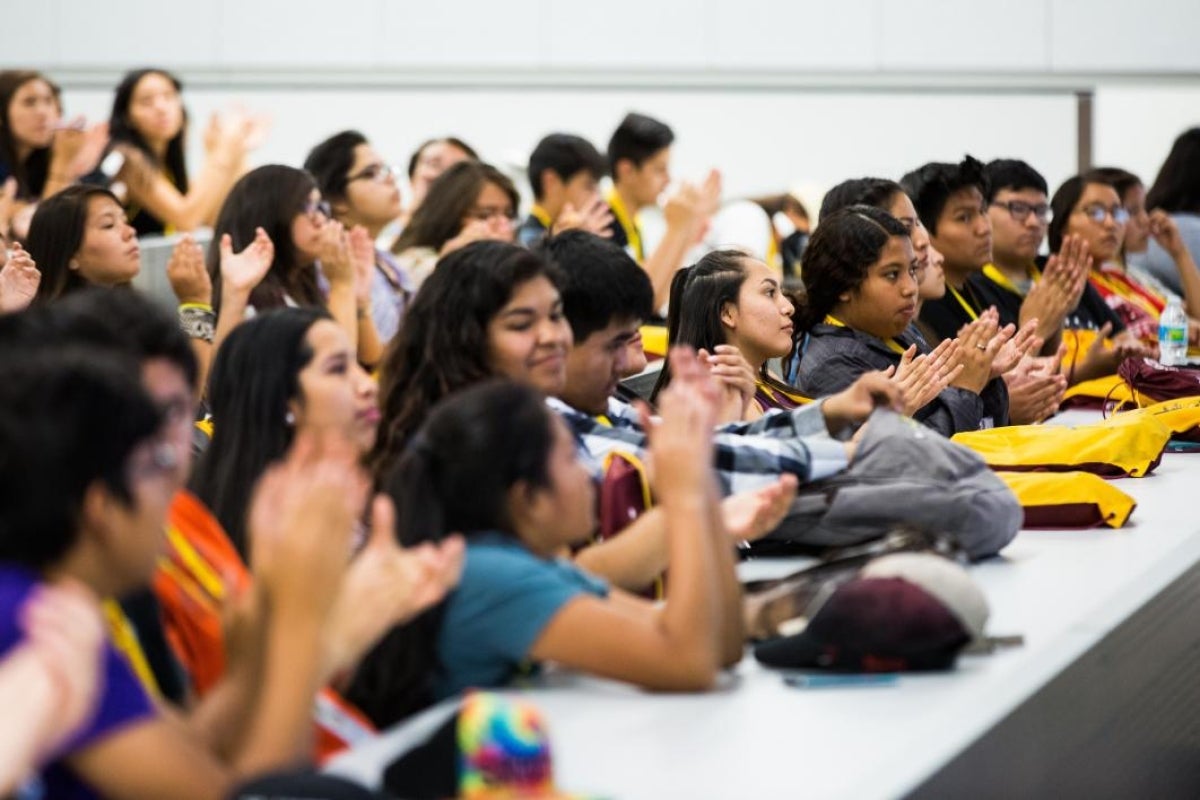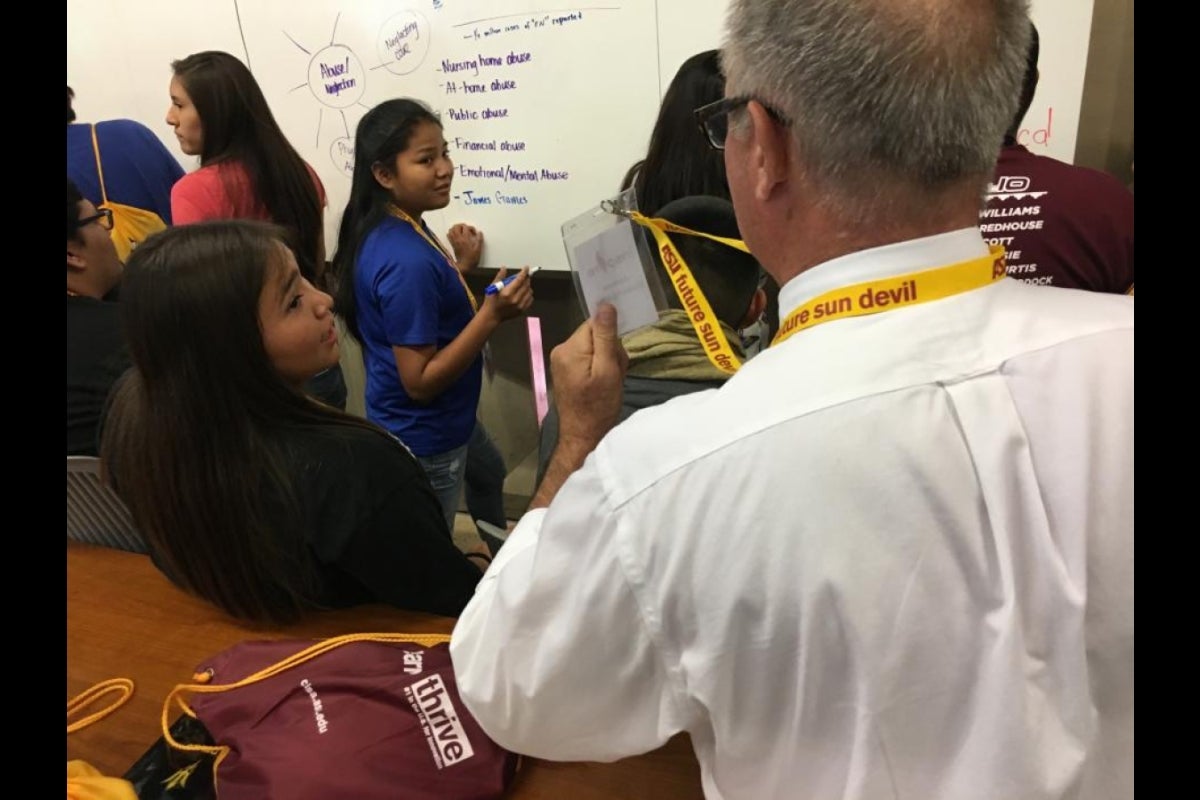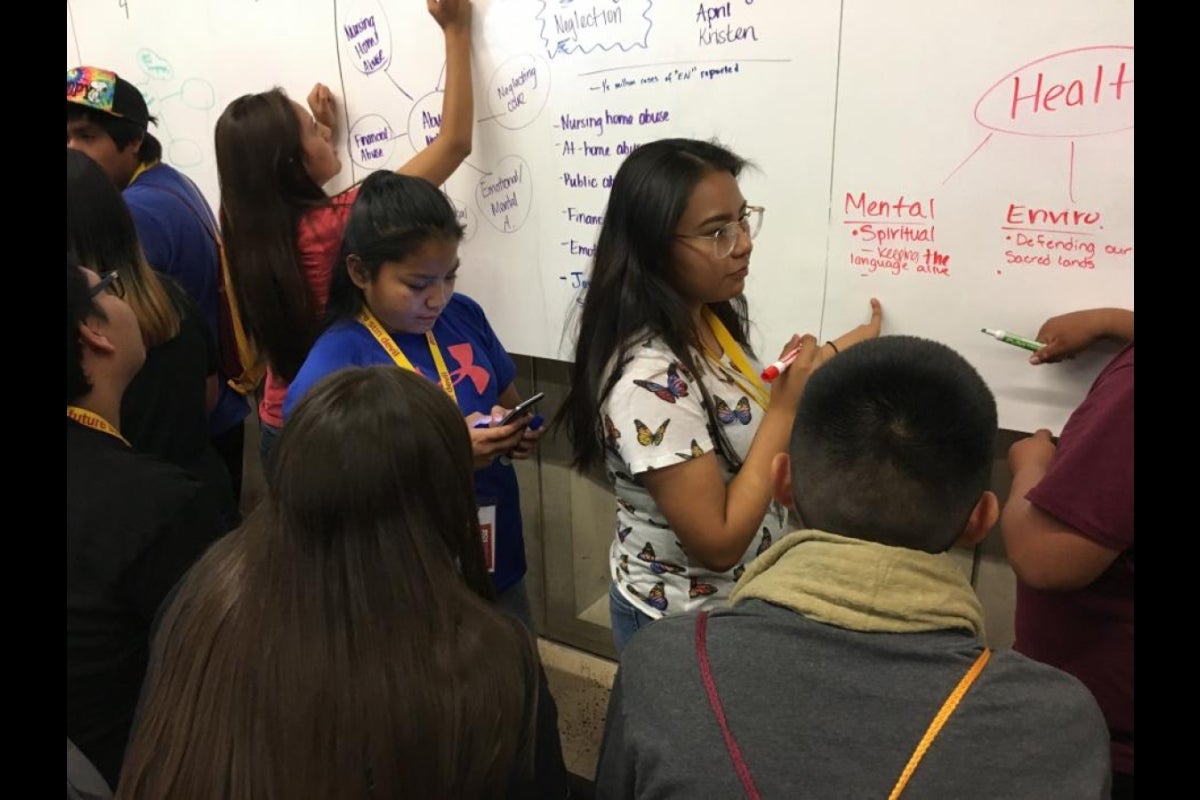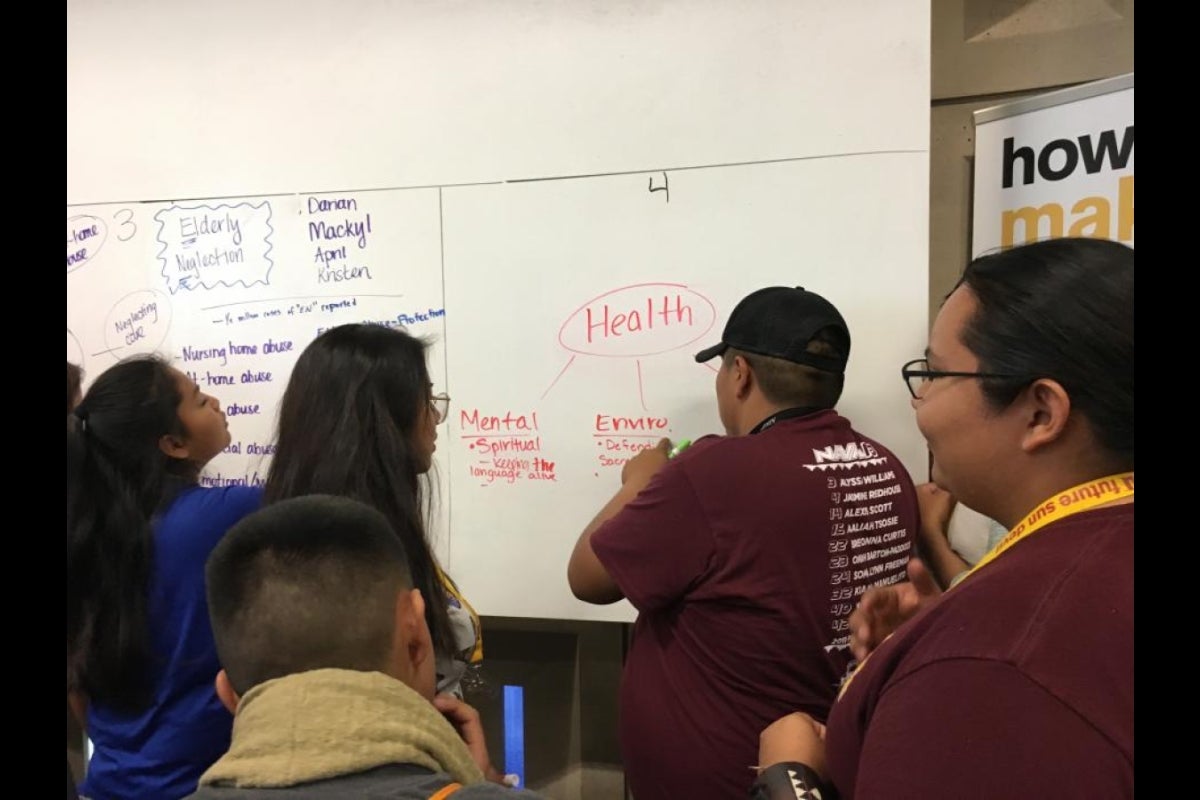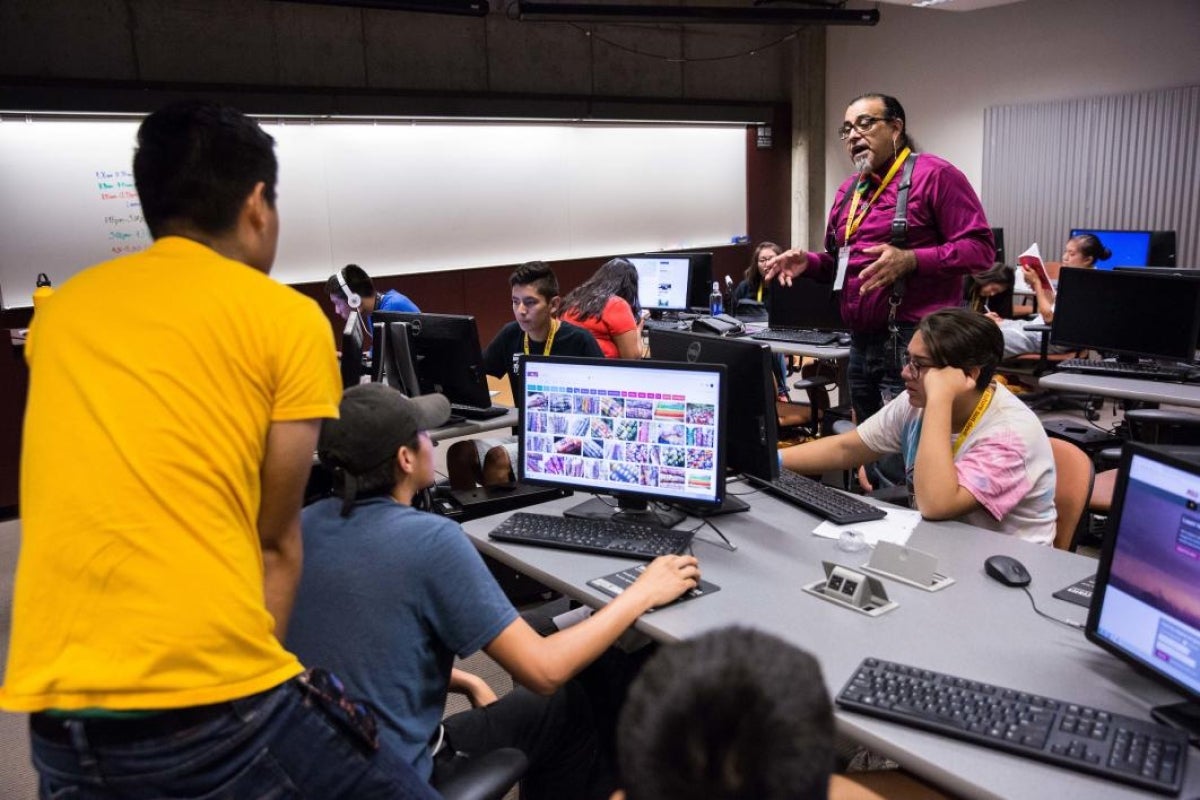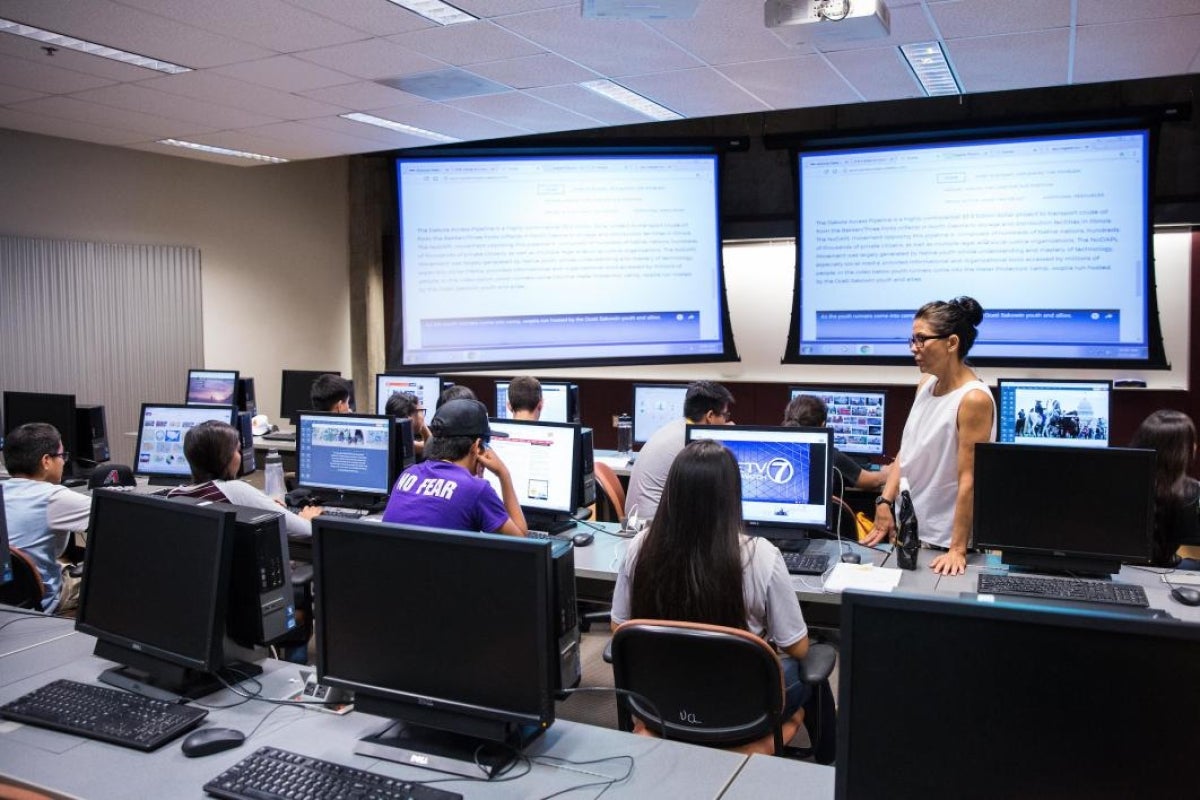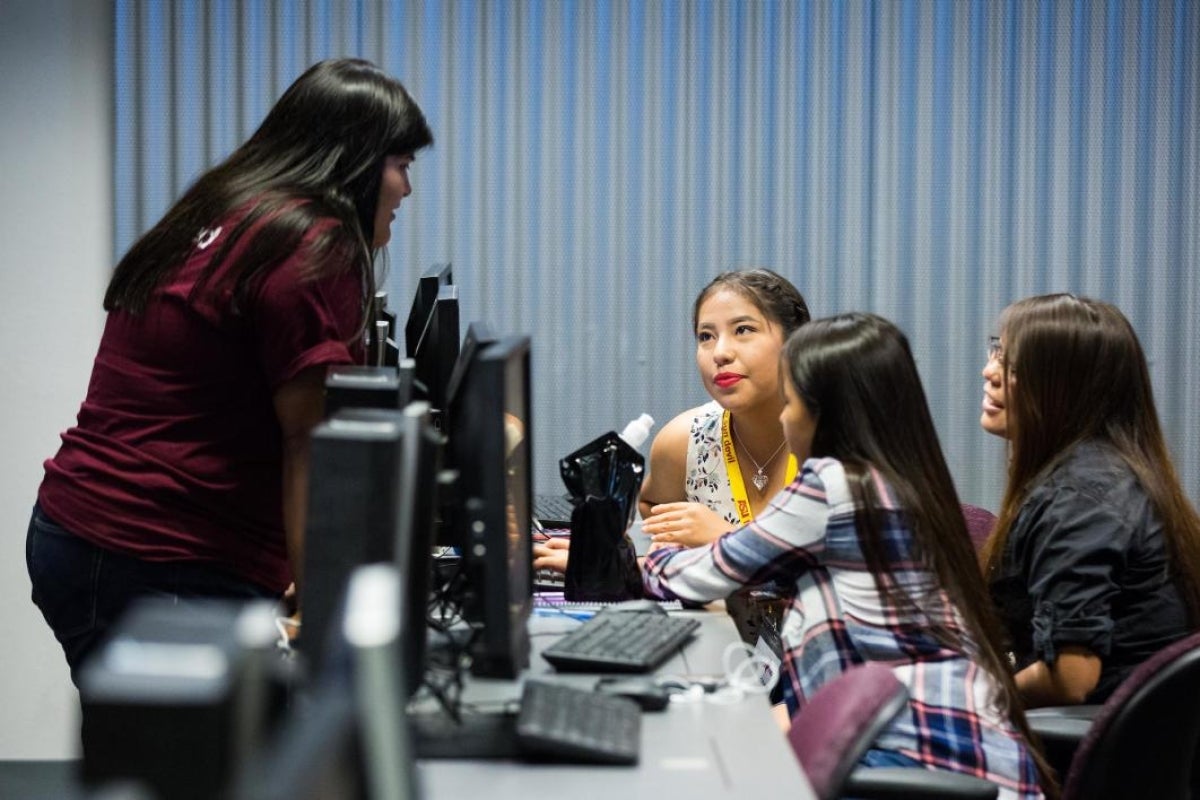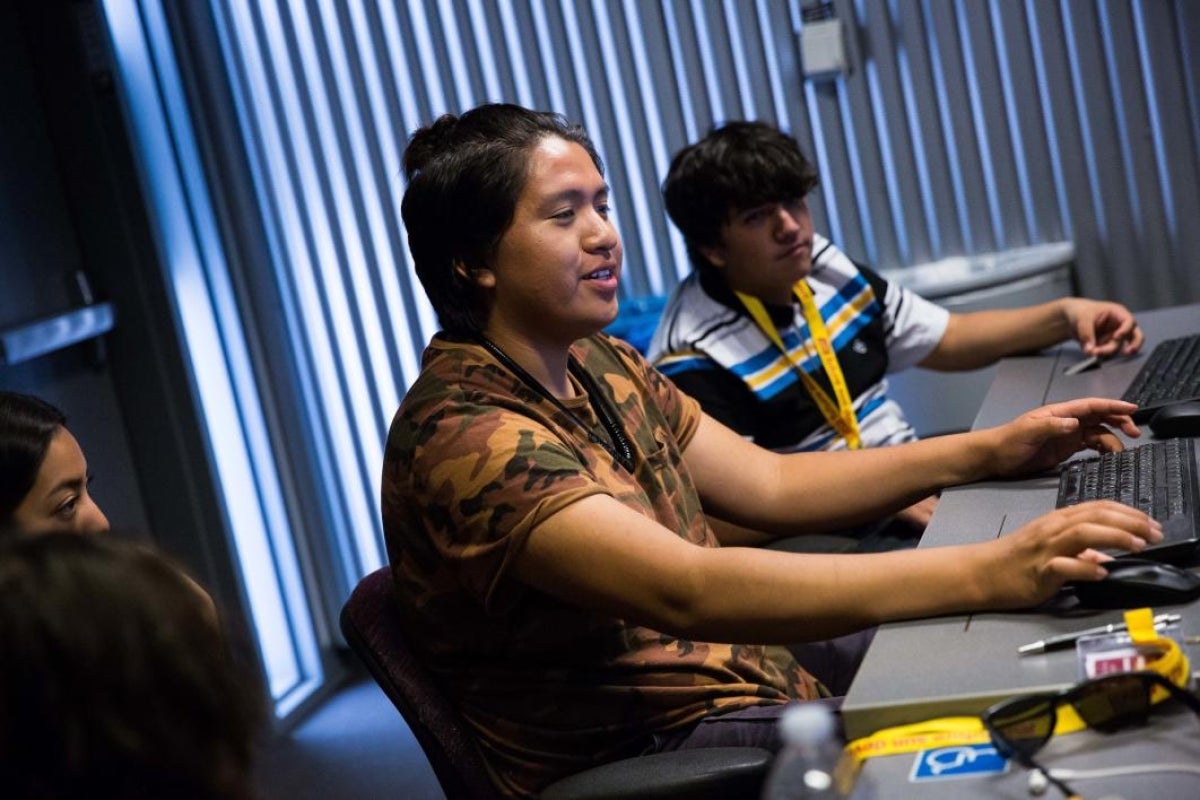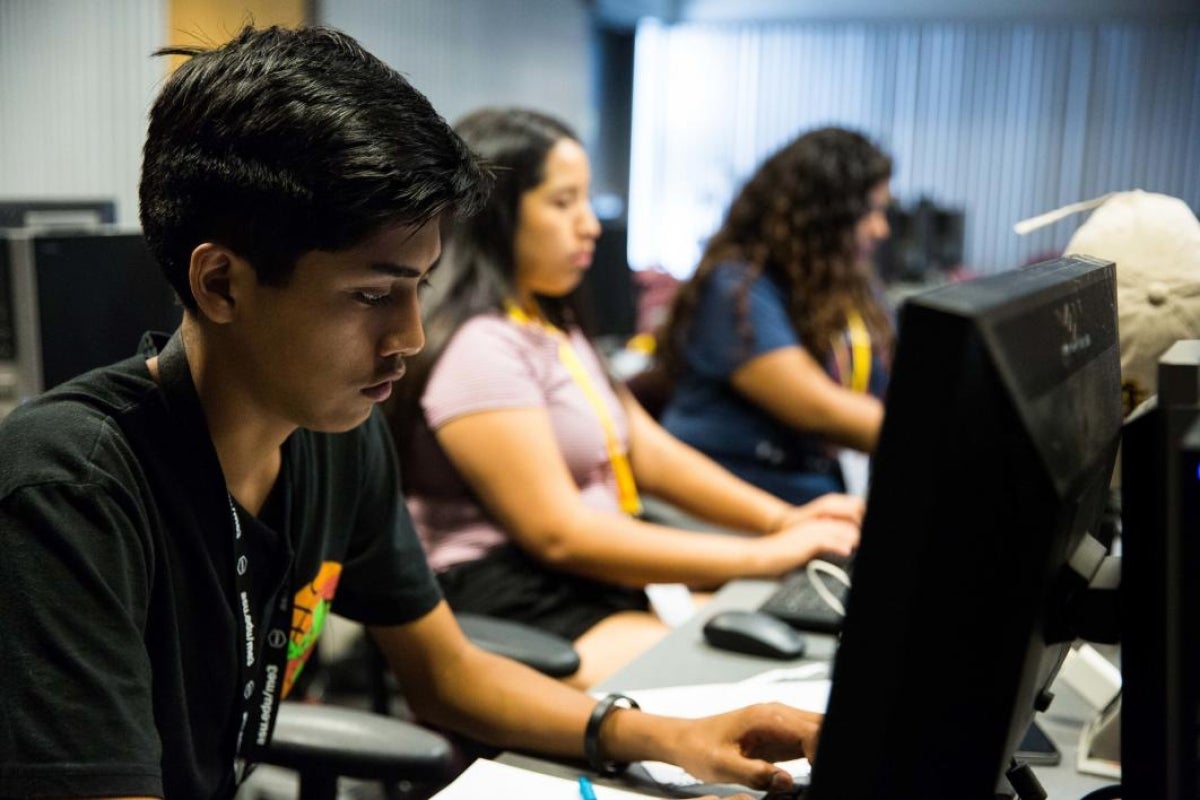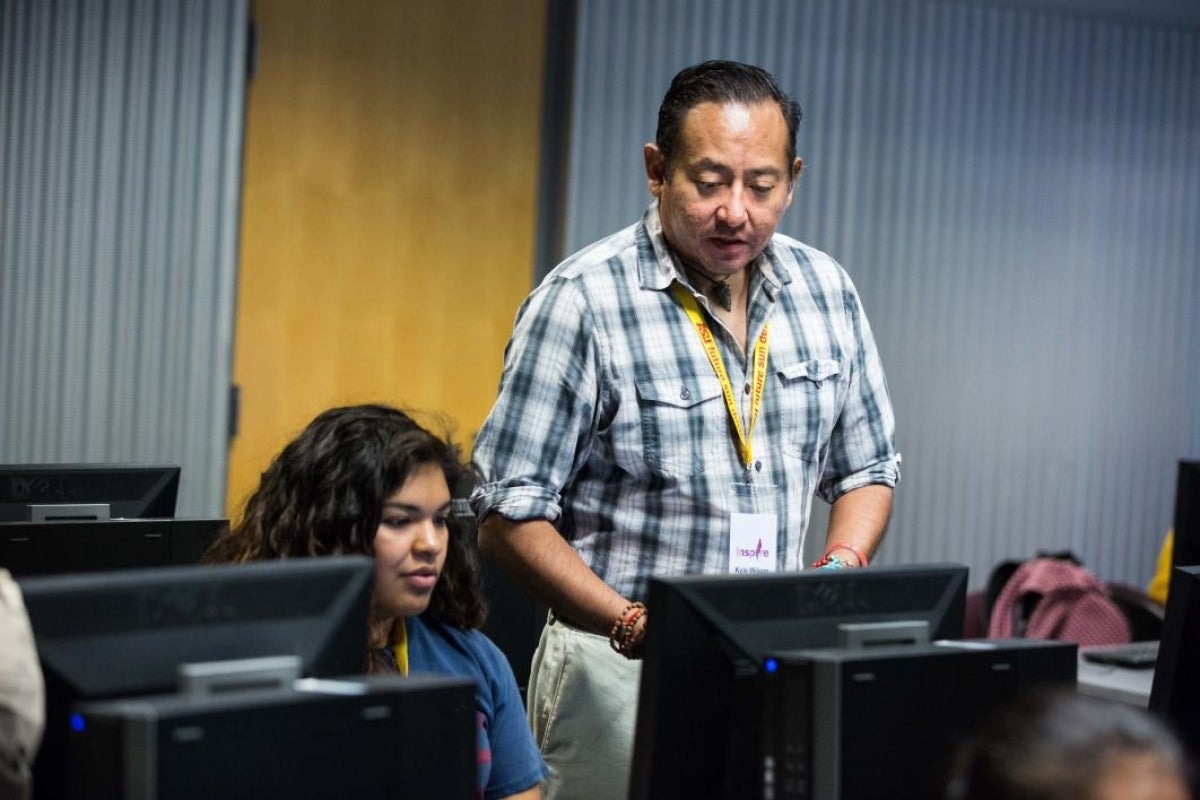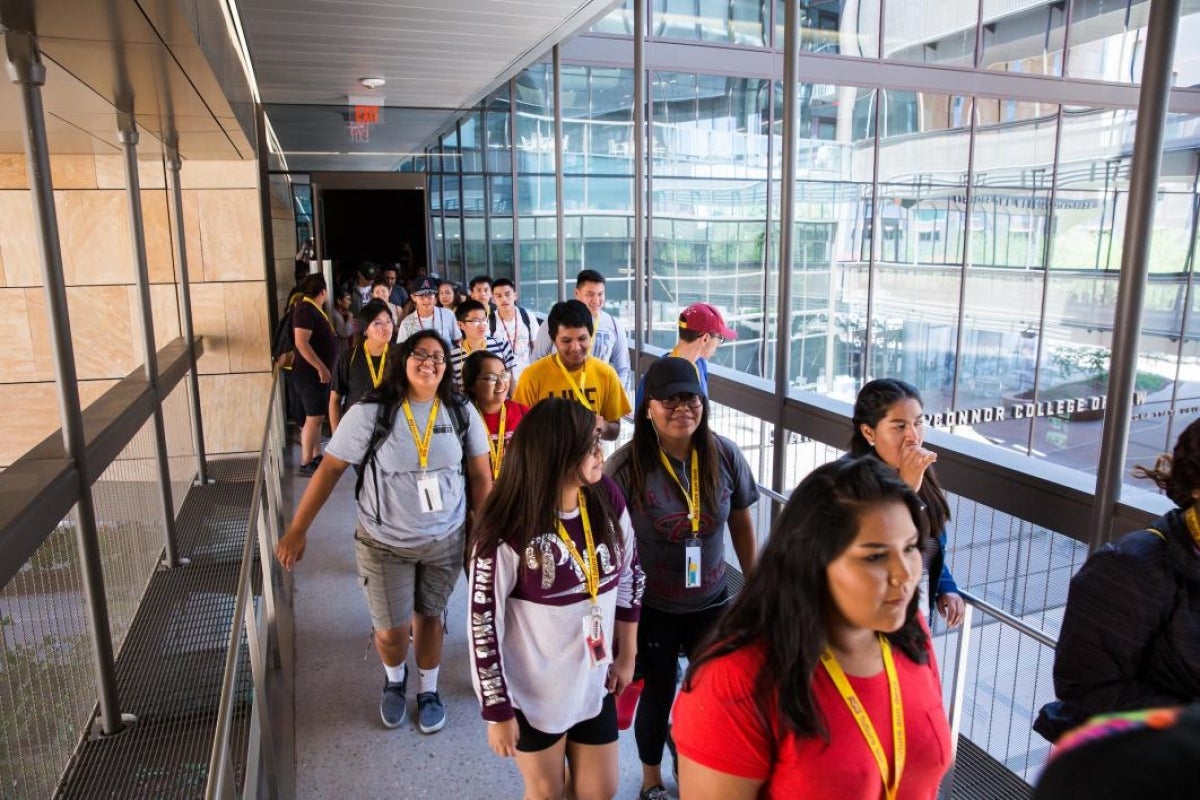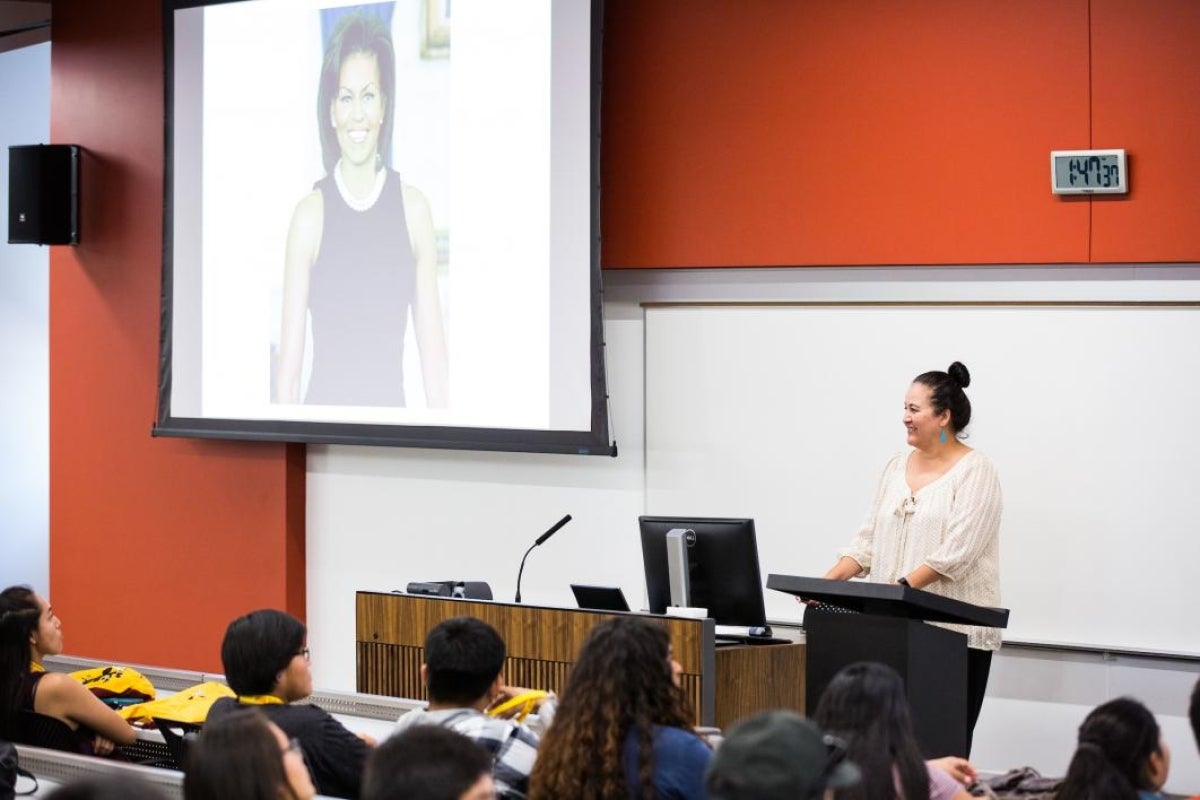Native students experience week of college life in ASU’s Inspire camp

It was day three of ASU’s 2017 Inspire program, the weeklong camp that offers high schoolers from tribal nations in Arizona a taste of college life, and the Arizona State University Memorial Union’s Changemaker space was abuzz.
The young scholars were working in 19 student teams, brainstorming and mapping out the action research plans they’d share with peers and families at the closing Capstone Project Showcase at week’s end. Their topic choices were informed by their own interests and the previous day’s panel presentations and discussions related to indigenous education; health; tribal sovereignty; and planning, architecture and construction in Indian Country.
The team of Kristen Sanderson, Darian Wauneka, Mackyl Ortega and April Yazzie, all rising high school seniors, had decided to pursue a research action plan related to health and well-being.
Sanderson’s career interests are nursing or dentistry. Wauneka leans toward optometry. Ortega is interested in working with pharmaceuticals, and Yazzie said she’d like to work for a company like Apple or Intel.
“Individually we suggested alcoholism, hospital misdiagnoses, heat-related deaths and elder neglect,” explained Sanderson.
As a group, they eventually settled on elder neglect by deciding to draw one topic lottery-style, Wauneka said.
Having done a lot of internet research in Inspire’s indigenous reading and writing workshop that morning, they worked quickly at the whiteboard, referring to the saved data on their phones and adding a few more ideas as they saw the flow of their research coming together.
A neighboring team had chosen to explore land conservation on tribal nations, and what can be done about the U.S. government’s pollution of the land.
“Some of the land appears to be unused; there’s no homes or burial grounds, so the government thinks, ‘Why can’t we build out here?’ In reality, that land is used for grazing or for growing crops and the ecosystem is thrown off by it,” said Noah Anaya, a 12th-grade student.
Another group looked at the election of the Navajo Nation president and how during the race the candidates’ focus on tradition and government affect the outcome.
“If the value placed on government is too high, it’s seen as a conflict with traditional values. I would like to see these values balanced, rather than one taking precedent over the other,” senior Vanessa Lee said.
“Outstanding work!” English Professor Jim Blasingame encouragingly shouted to all, as he finished a first lap around the room offering feedback to teams. “These are topics doctoral students are doing dissertations on.
“You’re worldly and you have your heads in the right place. Remember, you are your best resource,” he continued, as he offered tips about how to discern solid, reputable research facts from opinion. “Be wary of sources that use words like would, should, could, might. That author just wants to sell you on their ideas.”
Immersed in campus life
ASU’s college-readiness summer program Inspire, held June 18-24, saw nearly 100 American Indian students from tribal nations in Arizona participate in activities on ASU’s Tempe and Downtown Phoenix campuses and in the greater community.
Rising high school sophomores, juniors and seniors had the opportunity to practice and grow academic and personal success behaviors by integrating reading, writing and research skills in culturally relevant, project-based learning.
“You’re all capable and you’re going to learn new things and will grow,” said Jacob Moore, ASU assistant vice president for tribal relations, in his welcome to participants and their families on June 18. “Open your mind to possibilities and you may see some things differently than maybe what you’ve seen in high school. This is a chance for you to envision yourselves on campus and to see for yourself what being in college is like.”
During Inspire, students experienced university life in a Tempe campus residence hall. They ate in dining halls and enjoyed free time and team-building sessions in the Sun Devil Fitness Center. They worked with their peers and instructors in different buildings on the Tempe campus. They also enjoyed sessions at the Desert Botanical Garden, the Heard Museum and the Indian Legal Program at ASU’s Beus Center for Law and Society on the Downtown Phoenix campus.
Throughout the program the high schoolers were guided by 11 ASU indigenous students who served as team mentors, providing tips and advice that come best from near-peers.
“Living on campus has been interesting. Sharing a room and talking with someone else who has similar interests in going to college is great,” said senior Tyler Salt.
During one of the sessions, the students used the me3 tool to explore majors and careers that interested them, providing a glimpse of their future after high school.
“The career exploration has been my favorite part. I’ve always wanted to be a business administrator, and this is giving me the motivation to pursue it when I come [to ASU] next year,” said senior Hailey Veltha.
“I wanted to be a lawyer, but this has showed me different opportunities that are available to me in the different programs,” Anaya said.
By the end of the program, participants were connected with American Indian students, staff, faculty and support services at the university.
“Programs like Inspire are designed to motivate high school students to begin pursuing higher education, and so it’s important to connect them to the university in general,” said Lorenzo Chavez, director of family and student initiatives for Access ASU.
The program, now in its second year, emphasized the accessibility of the different resources at each of the ASU campuses with a resource fair representing ASU’s schools and colleges.
“We want Inspire participants to feel welcome and comfortable at ASU and understand the many opportunities they’ll find in terms of academics and support. Of course, we hope they will decide to apply to, enroll in and graduate from ASU in the future,” said Jeanne Hanrahan, director of community outreach for the College of Integrative Sciences and Arts, and University College.
“We received about 250 applications for this year’s program and could afford to offer places to 100 students. It's clear that interest in a program like this is strong,” she added.
This year’s Inspire program was sponsored by a grant from the Tohono O'odham Nation to ASU's University College and the Office of American Indian Initiatives, with support from Access ASU.
Chavez and Annabell Bowen, director of American Indian initiatives in the ASU Office of the President, presented a session for parents and families on the opening morning of Inspire. Bowen spoke about the cultural environment at ASU, and Chavez shared information about applying to the university, financial aid and what families can do to help their students in their decision about college.
“We have more than 2,800 American Indian students at ASU, making it one of the largest Native student bodies in the country,” Bowen told family members, “and enrollment numbers have been increasing every year.”
As part of her work in the Office of American Indian Initiatives, Bowen heads up the university’s Tribal Nations Tour program, in which current ASU students, faculty and staff travel to all of the tribal communities in Arizona in outreach to K-12 students.
“We even talk with kids in Head Start programs,” said Bowen. “It’s never too early to encourage children to start thinking about college and to have them get firsthand knowledge of the first steps they need to take to be ready.”
Will Argeros contributed to this story; william.argeros@asu.edu.
Top photo: Students make their way to the Indian Legal Program in the Beus Center for Law and Society at the ASU Downtown Phoenix campus during ASU's Inspire program for Native high school students. Photo by Deanna Dent/ASU Now


